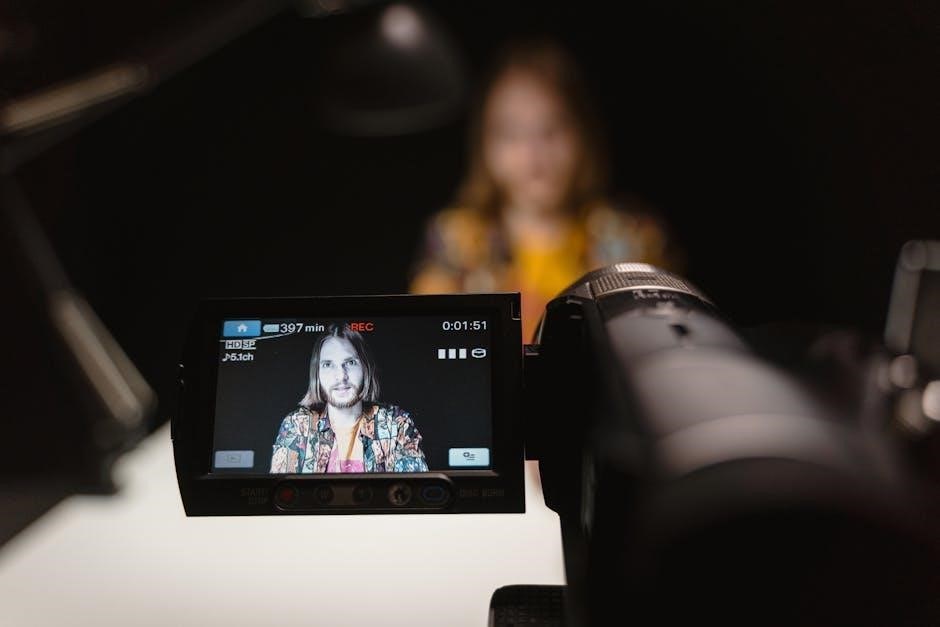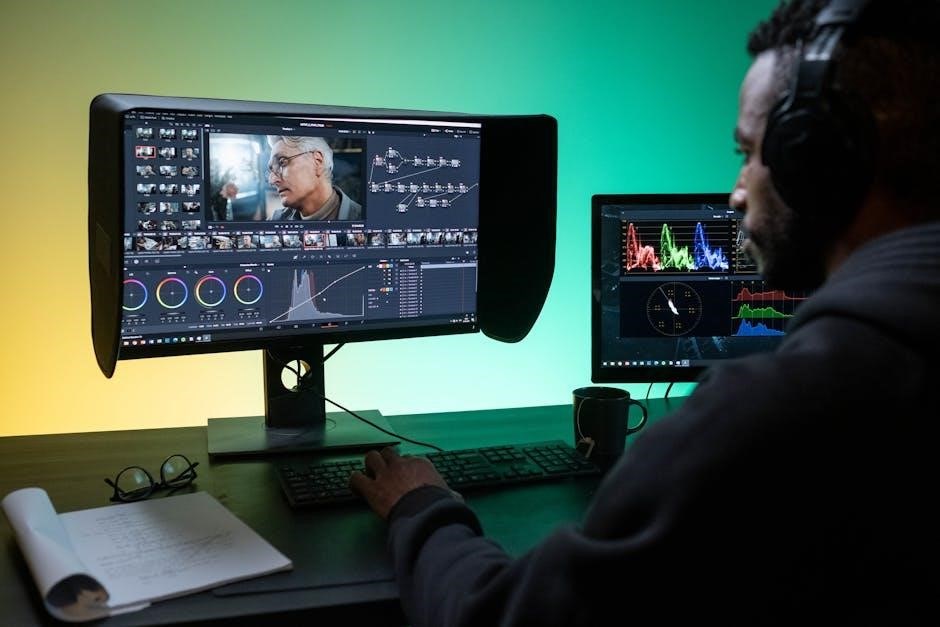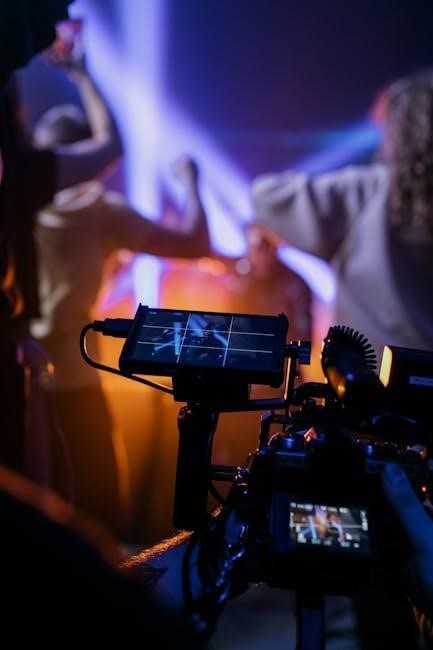The study of media effects examines how media influences beliefs, behaviors, and societal norms. It explores the historical context, theoretical foundations, and contemporary impact of media on individuals and society, offering insights into understanding its role in shaping culture and communication.
1.1 Definition and Scope of Media Effects
Media effects refer to the ways in which media influences individuals’ beliefs, behaviors, and attitudes, as well as broader societal norms and cultural values. The scope of media effects encompasses various forms of media, including television, film, internet, and social media, and examines both immediate and long-term impacts. This includes effects on cognition, emotion, and behavior, shaping perceptions of reality, fostering stereotypes, and influencing decision-making processes. Understanding media effects is crucial for navigating a media-saturated world and developing critical media literacy skills.
1.2 Historical Context of Media Influence
Historically, media influence has evolved alongside technological advancements, from print to digital platforms. Early research focused on mass media’s potential to shape public opinion, with theories emerging in the 20th century. The rise of television and radio marked a shift in media’s societal impact, influencing behavior and cultural norms. Today, the internet and social media dominate, amplifying media’s role in globalization and personal communication. Understanding this historical context is essential for grasping how media has progressively shaped human interaction and perception over time.
1.3 Evolution of Media Effects Research
Media effects research has transitioned from early theories like the hypodermic needle model to more nuanced frameworks. Initially, media was seen as a direct influencer of behavior, but later theories emphasized active audience roles. The rise of digital media and social platforms expanded research to include online interactions and user-generated content. Modern studies integrate diverse methodologies, blending quantitative and qualitative approaches to capture complex media effects. This evolution reflects shifting media landscapes and deepening understanding of how media shapes perceptions and behaviors in dynamic, interconnected environments.

Overview of “Fundamentals of Media Effects, Third Edition”
Fundamentals of Media Effects, Third Edition by Jennings Bryant and Bruce W. Finklea offers a comprehensive review of media influence, updated with contemporary research and case studies.
2.1 Publication Details and Authors
Fundamentals of Media Effects, Third Edition was published by Waveland Press, Inc. in 2022. The book is authored by Jennings Bryant and Bruce W. Finklea, renowned scholars in media studies. With ISBN-10: 1478648856 and ISBN-13: 9781478648857, it is available in paperback and digital formats. This edition provides updated insights into media influence, making it a valuable resource for students, researchers, and professionals exploring media effects. Its comprehensive approach ensures relevance in understanding contemporary media dynamics.

2.2 Key Features of the Third Edition
The third edition of Fundamentals of Media Effects offers a thoroughly revised and updated exploration of media influence. It includes research spotlights that connect theoretical concepts to real-world studies, enhancing reader understanding. The text covers ten key areas, such as media violence, sexual content, and political communication, providing a comprehensive overview of media’s impact. With engaging discussions and recent examples, this edition equips readers with media literacy skills, making it an essential resource for navigating today’s media-saturated environment.
2.3 Target Audience and Academic Relevance
Fundamentals of Media Effects, Third Edition is primarily designed for undergraduate students in communication, media studies, and related fields. It serves as a core textbook, offering an accessible yet comprehensive exploration of media influence. The book’s academic relevance lies in its updated content, research spotlights, and real-world examples, which help students develop critical thinking and media literacy skills. It is also a valuable resource for educators and professionals seeking to understand the evolving impact of media in society.

Foundational Theories of Media Effects
This section explores key theories that explain how media influences individuals and society, including the hypodermic needle theory, agenda-setting, and social learning theories.
3.1 Overview of Media Effects Theories
Media effects theories explore how media influences individuals and society, offering frameworks to understand its impact beyond entertainment. These theories examine cognitive, emotional, and behavioral changes, providing insights into media’s role in shaping perceptions, beliefs, and actions. They form the foundation of media effects research, guiding studies on topics like violence, sexual content, and political communication. This section introduces these theories, highlighting their evolution and application in understanding media’s complex role in modern society.
3.2 The Hypodermic Needle Theory
The Hypodermic Needle Theory posits that media messages are “injected” directly into audiences, influencing beliefs and behaviors uniformly. Emerging in the 1930s and 1940s, it suggested media had a powerful, direct impact on a passive audience. This theory was often linked to propaganda and mass persuasion, assuming media effects were immediate and consistent across individuals. However, it has largely been criticized for oversimplifying media influence, as later theories revealed more complex, interactive processes. Despite its limitations, it remains a foundational concept in media effects research, highlighting early concerns about media power.
3.3 Agenda-Setting Theory
Agenda-Setting Theory, developed by Maxwell McCombs and Donald Shaw, suggests that media influence public opinion by determining which issues are most important. The theory posits that the media sets the public agenda by highlighting certain topics, making them appear more significant. While the media doesn’t tell people what to think, it does influence what they think about. This theory emphasizes the media’s role in shaping priorities and has evolved to include second-level agenda-setting, which focuses on the attributes of issues. It remains a cornerstone in understanding media effects on public perception and societal priorities.
3.4 Uses and Gratifications Theory
Uses and Gratifications Theory posits that audiences actively seek media to fulfill specific needs and desires. Unlike other theories, it focuses on the audience’s perspective, emphasizing how individuals use media to satisfy cognitive, emotional, or social gratifications. This theory suggests that media consumption is purposeful, with viewers selecting content that meets their needs, such as entertainment, information, or social interaction. It highlights the active role of audiences in media consumption, challenging the notion of passive media effects and emphasizing individual agency in media use.
3.5 Social Learning Theory
Social Learning Theory, developed by Albert Bandura, suggests that individuals learn behaviors, attitudes, and knowledge by observing and imitating others. Media serves as a powerful tool for observational learning, where audiences model behaviors exhibited by characters or influencers. The theory emphasizes that learning is reinforced when observed behaviors lead to positive outcomes. Factors such as the model’s attractiveness, similarity to the observer, and the context of the behavior influence the likelihood of imitation. This theory highlights how media can shape behavior and attitudes through vicarious experiences.

Media Effects on Society
Media significantly shapes societal norms and behaviors, influencing violence, sexual content, political communication, and health perceptions, collectively shaping public opinion and cultural values.
4.1 Media Violence and Its Impact
Media violence exposure is linked to increased aggression, desensitization, and fear in audiences. Research highlights how violent content in TV, films, and video games can shape behavior, particularly in children. Empirical studies demonstrate that repeated exposure to violence in media can lead to long-term effects, including reduced empathy and increased aggressive thoughts. Theoretical frameworks, such as the General Aggression Model, explain how media violence influences cognitive, emotional, and behavioral processes. Understanding these impacts is crucial for developing strategies to mitigate harmful effects on individuals and society.
4.2 Media Sexual Content and Societal Norms
Media sexual content significantly influences societal norms, shaping perceptions of sexuality and relationships. Exposure to sexual media can lead to earlier sexual activity and distorted views of intimacy. Social cognitive theory suggests that individuals learn behaviors and norms by observing media portrayals. This content often perpetuates stereotypes and unrealistic beauty standards, affecting self-esteem and body image. Additionally, frequent exposure to sexual media can desensitize audiences, altering their attitudes toward sexual behavior and contributing to shifts in cultural values and norms over time.
4.3 Political Communication and Media Bias
Media bias significantly influences political communication, shaping public perceptions and beliefs. Selective exposure to partisan content reinforces ideological divides, while biased reporting can alter trust in institutions. The manipulation of information fosters polarization, as audiences gravitate toward media that aligns with their preexisting views. This selective amplification of certain narratives over others can distort public understanding of political issues, contributing to the erosion of civil discourse and the spread of misinformation in contemporary society.
4.4 Media Influence on Health Perceptions
Media significantly shapes health perceptions by disseminating information, influencing behaviors, and setting agendas. Coverage of health issues often frames risks, leading to exaggerated fears or complacency. Misinformation can spread rapidly, impacting public understanding of illnesses and treatments. Media campaigns, however, can also promote positive behaviors, such as vaccination or healthy lifestyles. The portrayal of health topics in media thus plays a dual role, both empowering and misleading audiences, highlighting the need for critical consumption of health-related content in today’s information-rich environment.

Media Effects on Individuals
Media influences individuals’ beliefs, behaviors, and perceptions, shaping emotional responses and cognitive processes. It impacts personal identity and decision-making, emphasizing the need for critical media consumption and literacy.
5.1 Media Influence on Behavior and Beliefs
Media significantly shapes individuals’ beliefs and behaviors through exposure to content, influencers, and narratives. Research highlights how repeated media consumption can alter perceptions, attitudes, and decision-making processes. For instance, media violence may increase aggression, while educational content fosters positive behaviors. The influence extends to belief systems, as media often frames societal norms and values. Understanding these dynamics is crucial for developing critical thinking and media literacy, enabling individuals to discern and respond to media messages effectively in a media-saturated world.
5.2 Media and Stereotyping
Media often perpetuates stereotypes by portraying groups in oversimplified or biased ways, reinforcing societal prejudices. This can lead to the formation of inaccurate perceptions about race, gender, culture, or professions. Exposure to stereotypical content may influence individuals’ attitudes and behaviors, fostering discrimination or misunderstandings. Media’s role in shaping stereotypes highlights the importance of critical consumption and diverse representation to challenge and overcome these harmful narratives, promoting a more inclusive and equitable society.
5.3 Media Literacy and Critical Thinking
Media literacy empowers individuals to critically analyze and interpret media content, fostering a deeper understanding of its intended and unintended messages. By developing critical thinking skills, people can discern credible information, identify biases, and recognize the persuasive techniques used in media. This ability is crucial in today’s information-overloaded world, where misinformation and manipulation are prevalent. Educating audiences to be media-literate encourages informed decision-making and active engagement with content, ultimately promoting a more discerning and resilient public.

Specific Areas of Media Effects

Media effects are examined across diverse domains, including violence, sexual content, political communication, health perceptions, stereotyping, educational television, video games, and internet/mobile communication impacts.
6.1 Media Violence and Aggression
Media violence exposure is linked to increased aggression, desensitization, and altered cognitive processing. Empirical studies highlight how violent content in media, such as movies, video games, and television, can shape aggressive behaviors and attitudes. Research has consistently shown that repeated exposure to violent media can lead to heightened emotional arousal, reduced empathy, and a greater propensity for aggressive actions. These effects are particularly pronounced in children and adolescents, who may imitate violent behaviors observed in media. Understanding these dynamics is crucial for addressing the broader societal impact of media violence on behavior and cognition.
6.2 Media Sexual Content and Behavior
Media sexual content significantly influences perceptions of sexuality, norms, and behaviors. Exposure to sexual media can shape attitudes toward intimacy, gender roles, and sexual practices. Research indicates that frequent consumption of sexual content may lead to unrealistic expectations, objectification of individuals, and an increased likelihood of risky sexual behaviors. Additionally, media portrayals often normalize certain behaviors, impacting societal norms and individual decision-making. The effects are particularly pronounced among youth, highlighting the need for critical media literacy to navigate these influences effectively.
6.3 Frightening Media Content and Anxiety
Frightening media content, such as horror movies or intense action scenes, can evoke strong emotional responses and increase anxiety levels. Exposure to such content may lead to heightened fear responses, sleep disturbances, or prolonged psychological distress in some individuals. Research suggests that repeated consumption of frightening media can desensitize audiences over time, though it may also amplify anxiety in vulnerable populations. Understanding these effects is crucial for developing strategies to mitigate negative impacts while fostering resilience in media consumers.
6.4 Educational Television and Learning
Educational television plays a significant role in promoting learning by providing engaging and accessible content. Shows like Sesame Street use colorful characters and songs to teach letters, numbers, and social skills, making complex concepts engaging for young audiences. These programs often incorporate problem-solving and critical thinking exercises, fostering cognitive development. Additionally, educational TV can bridge gaps in access to quality education, offering learning opportunities to children who may not have them otherwise. By reinforcing school lessons and sparking curiosity, educational television supports academic achievement and lifelong learning habits.
6.5 Video Games and Their Effects
Video games significantly influence behavior, cognition, and emotions, shaping user experiences through interactive engagement; Research indicates that violent games may increase aggression, while educational games enhance problem-solving skills. The impact varies based on game content and player interaction. Multiplayer games foster social connections, whereas addictive gameplay can lead to negative outcomes. Understanding these effects is crucial for promoting healthy gaming habits and leveraging games as tools for learning and development. The study of video game effects highlights their dual potential for harm and benefit in modern media culture.
6.6 Internet and Mobile Communication Effects
The internet and mobile communication have profoundly transformed how people interact, access information, and navigate daily life; Social media platforms, messaging apps, and online content shape perceptions, behaviors, and relationships. While these technologies enable global connectivity and information sharing, they also raise concerns about privacy, misinformation, and mental health impacts. Understanding these effects is crucial for fostering digital literacy and responsible media consumption in an increasingly connected world.

Research and Evidence in Media Effects
Research spotlights and case studies provide empirical evidence of media effects, linking theoretical frameworks to real-world applications and offering insights into how media influences society and individuals.
7.1 Research Spotlights and Case Studies
Research spotlights and case studies in media effects provide real-world examples of how theories translate into measurable outcomes. These empirical investigations examine specific instances of media influence, such as the impact of violent content on aggression or political communication on voting behavior. By analyzing these cases, researchers can identify patterns and understand the complexities of media effects; Such studies often incorporate diverse methodologies, including experiments, surveys, and content analyses, to offer actionable insights into how media shapes societal and individual behaviors.
7.2 Methodologies in Media Effects Research
Research methodologies in media effects vary, incorporating both quantitative and qualitative approaches. Quantitative methods include experiments, surveys, and content analyses, which provide numerical data to measure media impact. Qualitative methods, such as interviews and focus groups, offer deeper insights into audience interpretations and experiences. Mixed-method designs combine these approaches to triangulate findings, ensuring robust and comprehensive understanding of media effects. Each methodology has strengths and limitations, and their selection depends on the specific research question and context.
7.3 Challenges in Measuring Media Effects
Measuring media effects presents several challenges, including isolating media influence from other factors, the dynamic nature of media consumption, and ethical concerns in experimentation. Additionally, the vast array of media platforms complicates data collection, while individual differences in audience interpretation make generalization difficult. Researchers must also account for long-term versus short-term effects and the potential for unintended consequences, further complicating the assessment of media’s impact on beliefs, behaviors, and societal norms.

The Role of Media in Modern Society
Media serves as a vital source of information, enabling global communication and shaping societal norms. It influences culture, politics, and daily life, fostering connectivity and knowledge-sharing across the world.
8.1 Media as a Source of Information
Media serves as a primary source of information, keeping individuals informed about global events, societal trends, and cultural shifts. It plays a crucial role in education, enabling access to knowledge and fostering understanding of complex issues. The rise of digital platforms has transformed how information is disseminated, making it more accessible and widespread. Media’s ability to shape public perception highlights its influence on decision-making and behavior, underscoring its significance in modern society.
8.2 Media and Social Networking
Media, particularly social networking, has revolutionized interpersonal communication and connectivity. Platforms like Facebook, Twitter, and Instagram enable real-time interaction, fostering global relationships and communities. Media influences how individuals present themselves and engage with others, shaping identities and social dynamics. It also amplifies user-generated content, allowing individuals to share experiences and opinions widely. While these networks enhance connectivity, they also raise concerns about privacy, misinformation, and the blurring of personal and public spaces, highlighting the complex role of media in modern social interactions.
8.3 Media and Global Communication
Media has transformed global communication by bridging cultural and geographical divides. The internet and social networking enable instant information exchange across borders, fostering global dialogue. Media influences cultural exchange, allowing diverse perspectives to reach worldwide audiences. It facilitates international collaboration in fields like business, education, and politics. However, challenges such as language barriers and media bias persist. Despite these, media remains a powerful tool for promoting understanding and unity in an interconnected world, shaping how societies perceive and engage with global issues and cultures.
The conclusion summarizes media’s profound influence, tracing its historical development and theoretical evolution. Updated content highlights its relevance in today’s interconnected world, emphasizing the balance between opportunities and challenges.
9.1 Summary of Key Points
The third edition of Fundamentals of Media Effects provides a comprehensive overview of media’s influence on beliefs, behaviors, and societal norms. It explores historical developments, theoretical frameworks, and contemporary issues like media violence, sexual content, and political communication. The text emphasizes the dual role of media in shaping perceptions and fostering learning, while addressing challenges in measuring its impact. By integrating research spotlights and real-world examples, it equips readers with media literacy skills to navigate today’s complex media landscape effectively.
9.2 Future Directions in Media Effects Research
Future research in media effects will likely focus on emerging technologies, such as virtual reality and augmented reality, and their impact on behavior and cognition. Social media’s role in mental health and political polarization remains a critical area of study. Additionally, the influence of global communication networks and cross-cultural media effects will gain prominence. Methodological advancements, including longitudinal studies and interdisciplinary approaches, will enhance understanding of media’s complex and evolving role in shaping societies and individuals.

Leave a Reply
You must be logged in to post a comment.